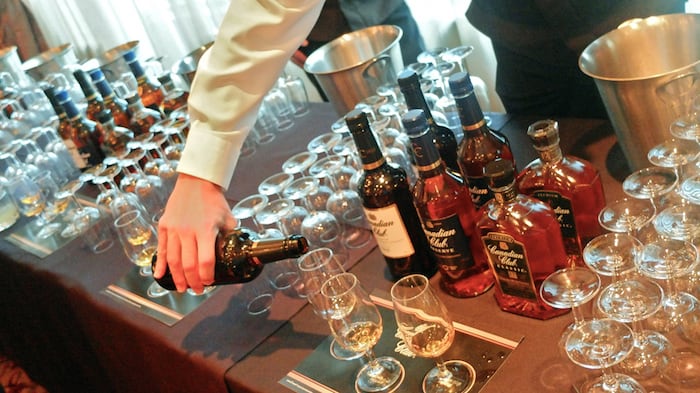Lies! Untruths! Misstatements! No, this isn’t a press conference from current political candidates, but an attempt to open a dialog on Canadian rye that rebuts some of the stereotypes and the sloppy accounting of spirits that are so frequently found in American glasses. Indeed, more than 70% of Canadian hootch crosses U.S. borders, so we should be more clear about what’s inside those barrels and bottles.
The first flag to pull down is that Canadian whiskies, because many of them are blends, have no gumption. Some critics have derided the lot as “brown vodka,” because some of the traditional mainstream Canadians have proved lighter on the palate than our hairy-chested craft bourbons. Not so much the case these days—and generalizations never make a good case anyway.
But before we get into any arguments, let’s talk about the origins of Canadian spirits.

River of Booze
Long before we began importing Canadian whisky, Canada imported it from Europe. Or, more accurately, imported the spirits makers, mostly English and German immigrants in the 18th and 19th centuries who already knew their way around a still. The ready availability of Canadian wheat made that the de facto grain for initial whisky interests, until German and Dutch settlers tossed rye into the mix, hoping for a bit more spice in the glass. For some time, that modest rye presence caused the errant labeling of all whisky from Canada to be dubbed “Canadian rye” in the U.S., since corn was the fallback grain for early U.S. whiskies. Corn figures significantly in many modern Canadian whiskies as well.
But see below for rye kicking up its Canadian heels once again.
Since the U.S. was the prime importer for Canadian product, Prohibition knocked Canada’s whisky makers back on their barrels, notwithstanding the number of enterprising American bootleggers who legged their way between borders to keep a portion of the flow flowing. The Detroit River between Canada and the States was allegedly dubbed “the river of booze” during this period. When Prohibition waned, whisky imports from the North waxed, and Canadian whisky became a household drink in the U.S. once again.
No Mashing, Just Mingling
A significant distinction between distillation practices in the U.S. and Canada is that Canadian distillers distill each grain separately and then blend the products, while American companies use a combined mash bill. Canadian whisky expert Davin de Kergommeaux, author of Canadian Whisky: The Portable Expert says, “Two key things about production are: first, that each grain is distilled separately, then the spirit is blended afterwards, instead of the grains being blended before fermentation. Second, most, but not all, distilleries distill all the components of their whiskies, so Canadian whiskies are best described as “single-distillery blends.”
Single distilleries of size and history in Canada are a narrow concentration of eight: Hiram Walker (Canadian Club) in Ontario is the largest, and that province also hosts Canadian Mist and Forty Creek. Highwood (Centennial), Black Velvet and Alberta Distillers (Alberta Rye) are in Alberta. Valleyfield/Schenley (Seagram’s VO) holds down the east in Quebec, while Gimli’s (Crown Royal) in Manitoba mans the middle of the country. With renewed interest in Canadian booze, all are expanding.
Interestingly, many of the provinces have some province-exclusive distillation regulations, though the national Food and Drugs Act mandates the fundamentals of all Canadian whisky: distillation in Canada, not less than 80 proof, and aged in wood for a minimum of three years.

Flavor: Velvet, or Velvet Hammer?
But let’s return to the heart—well, the taste—of the matter, regarding the “brown vodka” comment above. It’s true in the 60s and early 70s Mad Men era something like the basic Canadian Club was a kind of “mix it and forget it” offering, appreciated for its go-down-easy drinkability. There are still a number of light-but-lively north-of-the-border spirits that have only middling mid-tones and mild finishes, but those no longer captain the Canadian compass. Many of today’s whiskies are defined by notes of toffee, pepper, bananas, tobacco and yes, since we are talking Canada, maple.
Consider Forty Creek’s Double-Barrel Reserve, described on the site as having “… golden roasted aroma filled with deep vanilla notes and highlighted with toasted spice, pecan and walnuts.” Or perhaps Collingwood’s 21-Year Old Rye (and yes, these bombs marked “rye” really are rye these days), described on the Bourbon Guy site as having a “black tea” nose, “vanilla bean ice cream” mouth and “some mint, some caramel” finish.
The venerable Crown Royal has recently released, from its Noble Collection, the Cornerstone Blend, which combines a spicy Canadian rye, a coffey-still whisky and a bourbon-style whisky into a quaff with a palate that’s “… filled with robust flavors of shaved nuts, oak, and orchard and tropical fruits.” And note this notable: Jim Murray’s Whisky Bible awarded Crown Royal’s Northern Harvest Rye the 2016 World Whisky of the Year.
Getting Crafty North of the Border
Besides the old-timers freshening their acts with small-batch releases, Canada—though not on the scale of the US..—also has a developing craft distillery industry. There is a directory here on Davin de Kergommeaux’s definitive Canadian Whisky site. As he points out, it will be some time before these new distilleries are releasing whiskies, but there is great promise.
With all the changes and diverse products—most for the good—happening in the Canadian whisky world, de Kergommeaux says there are still some constants that hold true: “The essence of Canadian whisky is its elegance. Even the most robust Canadians benefit from long aging in used barrels. This lets the spirit develop slowly, bringing out all kinds of subtleties. The typical profile begins with caramel, then quickly some bracing pepper and ends with an appealing bitter pith. Around this are draped all kinds of fruits, flowers, spices, minerals and so on.”
Being draped with fruits, flowers, spices, and minerals doesn’t sound half bad. Drink up.







